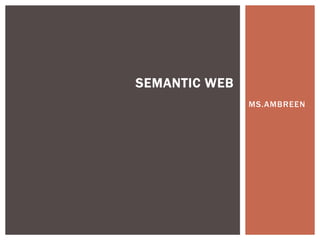
Semantic Web
- 3. LECTURE#9 BASIC SPARQL QUERY PROGRAMMING SKILLS
- 4. A typical query includes the following structure, some parts are optional: Declear prefix shortcuts (optional) PREFIX foo: <...> Query result clause SELECT ... Define the dataset (optional) FROM <...> Query pattern WHERE { ... } Query modifiers (optional): Group BY ... HAVING ORDER BY LIMIT OFFSET VALUES QUERY STRUCTURE IN SPARQL
- 5. rdf: http://xmlns.com/foaf/0.1/ rdfs: http://www.w3.org/2000/01/rdf-schema# owl: http://www.w3.org/2002/07/owl# xsd: http://www.w3.org/2001/XMLSchema# dc: http://purl.org/dc/elements/1.1/ foaf: http://xmlns.com/foaf/0.1/ obo: <http://purl.obolibrary.org/obo/> COMMON PREFIXES
- 6. Similar to its use in SQL, SELECT in SPARQL allows you to define which variables you want values returned and output. Like SQL you can list these individually or use an asterisk (*) to specify values for each variable. E.g. SELECT ?a ?text SELECT * If you don't want duplicates you can append DISTINCT after SELECT. e.g., SELECT DISTINCT ?country HOW TO SELECT?
- 7. The WHERE clause defines where you want to find values for the variables defined in the SELECT clause. HOW TO PROGRAM INSIDE WHERE?
- 8. The basic unit is a triple, which is made up of three components, a subject, a predicate and an object. Each of the three components can take one of two forms: put a ? prior to the variable name, e.g., ?a. a Universal Resource Identifier (URI). Note: A prefix for the namespace of the URI can be utilized. These triples can then be concatenated together using a full-stop (.). Eventually, an interconnected graph of nodes joined by relationships is built up. A semi-colon (;) can be used after each triple to replace the subject for the next triple if it is the same. In this way, you only need to define the predicate and object. e.g., ?x rdf:type mebase:User ; foaf:homepage ?homepage ; foaf:mbox ?mbox TRIPLE REPRESENTATIONS.
- 9. The UNION clause: return results to match at least one of multiple patterns The OPTIONAL clause is also often used. The FILTER clause filters the results based on certain conditions. CLAUSES
- 10. A solution sequence modifier is one of: Order modifier: put the solutions in order Projection modifier: choose certain variables Distinct modifier: ensure solutions in the sequence are unique Reduced modifier: permit elimination of some non-distinct solutions Offset modifier: control where the solutions start from in the overall sequence of solutions Limit modifier: restrict the number of solutions HOW TO USE MODIFERS?
- 11. This section provides many examples on how to query the RDF triple store: Example #1: Find all class-containing ontology graphs: This example is aimed to find all ontologies in our RDF triple store. Typically every single ontology includes at least one class. This SPARQL script searches those ontology graphs in the RDF triple store that contains at least one class. SPARQL EXAMPLES TO QUERY RDF TRIPLE STORE
- 12. PREFIX rdf: <http://www.w3.org/1999/02/22-rdf-syntax-ns#> PREFIX owl: <http://www.w3.org/2002/07/owl#> SELECT distinct ?graph_uri WHERE { GRAPH ?graph_uri { ?s rdf:type owl:Class } . } BELOW IS THE SPARQL SCRIPT:
- 13. Example #2: Find subclasses of an ontology term: This example is aimed to find all subclasses of an ontology term.
- 14. PREFIX obo-term: <http://purl.obolibrary.org/obo/> SELECT DISTINCT ?x ?label FROM <http://purl.obolibrary.org/obo/merged/OAE> WHERE { ?x rdfs:subClassOf obo-term:OAE_0000001. ?x rdfs:label ?label. } BELOW IS THE SPARQL SCRIPT:
- 15. Example #3: Find the number of all class (or object, annotation, or datatype property) terms of an ontology: This example is aimed to find the number of all class terms of an ontology.
- 16. SELECT count(?s) as ?VO_class_count FROM <http://purl.obolibrary.org/obo/merged/VO> WHERE { ?s a owl:Class . ?s rdfs:label ?label . FILTER regex( ?s, "VO_" ) } BELOW IS THE SPARQL SCRIPT:
- 17. Example #4: Retrieve definition and authors of all classes in an ontology: This example is aimed to retrieve the definitions of all classes that have definitions in an ontology.
- 18. PREFIX obo-term: <http://purl.obolibrary.org/obo/> SELECT ?s ?label ?definition ?author FROM <http://purl.obolibrary.org/obo/merged/VO> WHERE { ?s a owl:Class . ?s rdfs:label ?label . ?s obo-term:IAO_0000115 ?definition . ?s obo-term:IAO_0000117 ?author . } BELOW IS THE SPARQL SCRIPT:
- 19. Example #5: Retrieve general annotations of an ontology: This example is aimed to retrieve general annotation descriptions of the ontology. The result will return different types of annotations such as "creator", "description"s, etc.
- 20. PREFIX owl: <http://www.w3.org/2002/07/owl#> SELECT DISTINCT ?p, ?o FROM <http://purl.obolibrary.org/obo/merged/OAE> WHERE{ ?s a owl:Ontology . ?s ?p ?o .} BELOW IS THE SPARQL SCRIPT
- 21. Example #5: Query on axiom: Find vaccines containing egg protein allergen: The above examples are mostly based on ontology annotation properties. How to perform SPARQL queries based on logical axioms with object properties (or relations)? Here we provide some example.
- 22. PREFIX has_vaccine_allergen: <http://purl.obolibrary.org/obo/VO_0000531> PREFIX chicken_egg_protein_allergen: <http://purl.obolibrary.org/obo/VO_0000912> SELECT distinct ?vaccine_label ?vaccine FROM <http://purl.obolibrary.org/obo/merged/VO> WHERE { ?vaccine rdfs:label ?vaccine_label . ?vaccine rdfs:subClassOf ?vaccine_restriction . ?vaccine_restriction owl:onProperty has_vaccine_allergen:; owl:someValuesFrom chicken_egg_protein_allergen: . } BELOW IS ONE SUCH SPARQL SCRIPT:
- 23. Prefix obo: <http://purl.obolibrary.org/obo/> SELECT distinct ?label ?s From <http://purl.obolibrary.org/obo/merged/VO> Where { ?s rdfs:label ?label . ?s rdfs:subClassOf ?s1 . ?s1 owl:onProperty obo:VO_0000531; owl:someValuesFrom obo:VO_0000912 . } NOTE THAT THE FOLLOWING CODE HAS THE SAME EFFECT AS THE TOP CODE:
- 24. The difference between the above two sets of SPARQL codes is that the first one looks easier to read.